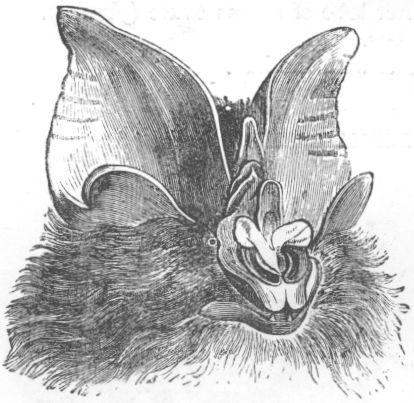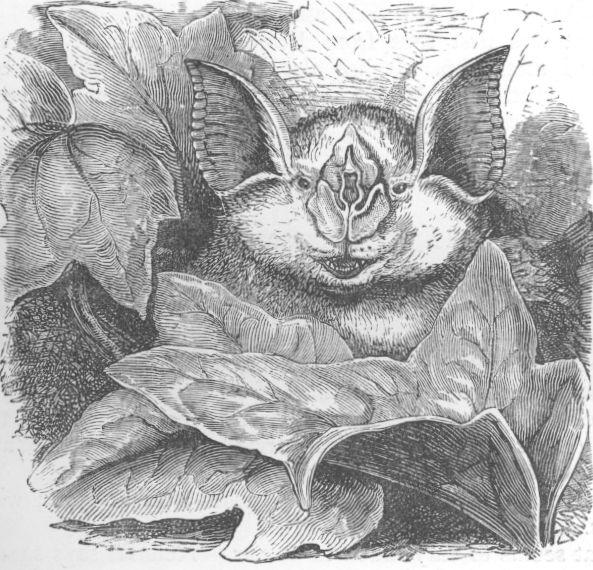| Page 17 | |
|
Natural History of the Mammalia of India and Ceylon - by Robert A. Sterndale F.R.G.S., F.Z.S. (1884) | |
| prev page next page | contents |
RHINOLOPHINÆ.
Nasal leaf complicated, and crests resting on the forehead, presenting more or less the figure of a horse-shoe; tail long and placed in the interfemoral membrane; ears large, but separate, and not joined at the base, as in the last genus; without a tragus, but often with a lobe at the base of the outer margin; wings large and long; forefinger of a single joint.
GENUS RHINOLOPHUS.
Nose-leaf cordate, or semi-orbicular, bi-lobed in front of the nostrils; a longitudinal crest along the nose and an erect frontal leaf posteriorly more or less lanceolate.—Jerdon.
Dental formula: Inc., 2/4; can., 1—1/1—1; premolars, 2—2/2—2; molars, 3—3/3—3.
39. RHINOLOPHUS PERNIGER vel LUCTUS, The Large Leaf-Bat (Jerdon's No. 17).
HABITAT.—Nepaul, Darjeeling, Khasya Hills.

Rhinolophus luctus DESCRIPTION.—Ears very large, much longer than the head; broad, acutely pointed; nasal apparatus very complicated; the lower leaf very large, concealing the upper lip like a door knocker; the upper leaf like a graduated spire; ears transversely striate; a rather large semi-circular lobe at base of ear; fur long, dense, soft, and lax, slightly curled or woolly black with a silvery grizzle, or greyish-black or rich chestnut-brown.—Jerdon.
SIZE.—Length, 3¾; tail, 1¾; wing expanse, 17 inches.
40. RHINOLOPHUS MITRATUS,
The Mitred Leaf-Bat (Jerdon's No. 18).
HABITAT.—Chybassa, Central India, Mussoorie(?)
DESCRIPTION.—Ears large; anti-helix moderately developed; upper leaf triangular acute; tail extending beyond the tibia; color above light brown; paler beneath.—Jerdon.
SIZE.—Head and body, 2½ inches; tail, 1½ inch; wing expanse, 12 to 14 inches.
41. RHINOLOPHUS TRAGATUS vel FERRUM-EQUINUM, The Dark-brown Leaf-Bat (Jerdon's No. 19).
HABITAT.—Nepaul, Mussoorie.

Rhinolophus ferrum-equinum DESCRIPTION.—Upper process like a barbed spear-head; central one small and narrow, a little expanded at the summit; anti-tragus less developed than usual; lips simple; colour a uniform deep brown, with tips of the hair paler, and somewhat rusty.—Jerdon.
SIZE.—Head and body, 2-5/8 inches; tail, 1-7/8 inch; wing, 15½ inches.
The tail of this species seems unusually long. It is found in cavities of rock, and issues forth soon after dusk—sooner, according to Hodgson, than the species of vespertilio.
42. RHINOLOPHUS PEARSONII, Pearson's Leaf-Bat (Jerdon's No. 20).
HABITAT.—Lower Himalayan range, Darjeeling, Mussoorie, &c.
DESCRIPTION.—Colour above dark brown, with a slight shade of chestnut; underneath brown, with a sooty cast; fur very long, dense and soft; ears distinct, with an additional rounded lobe below, measuring anteriorly nearly three-fourths of an inch; point of the facial crest moderately developed; length from the tip of the nose to root of tail three inches; tail half an inch; length of fore-arm two inches; expanse of the wings eleven inches. Although allied to Mr. Hodgson's R. tragatus, possesses distinct characters.—Horsfield.
SIZE.—As given by Horsfield above.
This bat was first sent from Darjeeling by Mr. J. T. Pearson, and was named after him. It has also, according to Jerdon, been found by Captain Hutton at Mussoorie; it is therefore reasonable to suppose that it inhabits the whole range of the lower Himalayas. One striking difference between it and the last species is the very short tail, and it is easily to be recognised by the great length of the fur.
43. RHINOLOPHUS AFFINIS, The Allied Leaf-Bat (Jerdon's No. 21).
HABITAT.—Ceylon, Burmah, and perhaps the Malabar coast.
DESCRIPTION.—Above bright red ferruginous brown; tips of hair darker, paler beneath; ears pointed and external; edge deeply emarginated; internal edge and basal third of external surface hairy; anti-helix well developed; nasal process apparently very similar to that of R. mitratus (Kellaart). Upper leaf triangular, emarginate at the tip, reaching above the base of the ears (Jerdon).
SIZE.—Head and body about 2-3/10 inches; tail, 1 inch; wing extent, 12 inches.
This bat seems to vary much in colour. Kellaart says some are of a brighter red than others, and a few had a yellower tinge. Another marked variety was of a uniform pale yellow brown.
44. RHINOLOPHUS ROUXI, The Rufous Leaf-Bat (Jerdon's No. 22).
HABITAT.—India generally.
DESCRIPTION.—Ears large, pointed, externally notched; tragus broad; tips of upper nose-leaf triangular, with its sides well emarginate, reaching above the base of the ears; no upper incisors [as in Megaderma lyra]; lower molars only five; canines very large; fur short, crisp; colour above smoky brown in some, reddish brown in others, and golden rufous in some; beneath paler.—Jerdon.
SIZE.—Length, 2-3/8 inches; tail, 1-1/8; wing expanse, 13 inches.
Hodgson considers this bat as allied to the two following species. It is the R. lepidus of Blyth.
45. RHINOLOPHUS MACROTIS, The Large-eared Leaf-Bat (Jerdon's No. 23).
HABITAT.—Lower Himalayas.
DESCRIPTION.—Ears very large, broad, oval, with pointed recurved tip, and a large obtuse tragus; anterior central crest of nose-leaf produced in front over the top of the flat transverse front edge; hinder leaf lanceolate triangular; above sooty brown or light earthy olive-brown, paler below, some with a rufous or Isabelline tint; no pubic teats.—Jerdon.
SIZE.—Head and body, 1¾ inch; tail, ¾; wing expanse, 9¾.
46. RHINOLOPHUS SUB-BADIUS, The Bay Leaf-Bat (Jerdon's No. 24).
HABITAT.—Nepaul.
DESCRIPTION.—Ears not larger than the head, obtusely pointed and ovoid; nasal appendage quadrate, with a transverse bar nearly surmounting it; upper leaf triangular, with slightly emarginate sides; clear brown above, paler below and on head and face.
SIZE.—Head and body, 1½ inch; tail, 1¼; wing expanse, 7½.—Jerdon.
